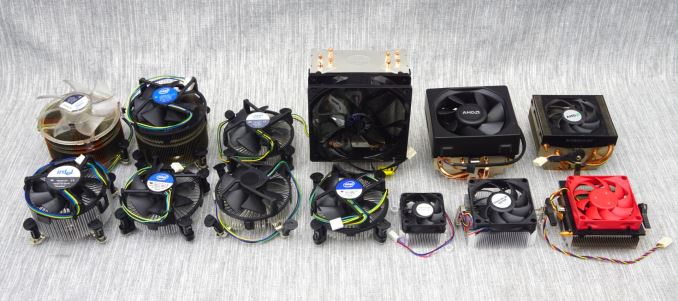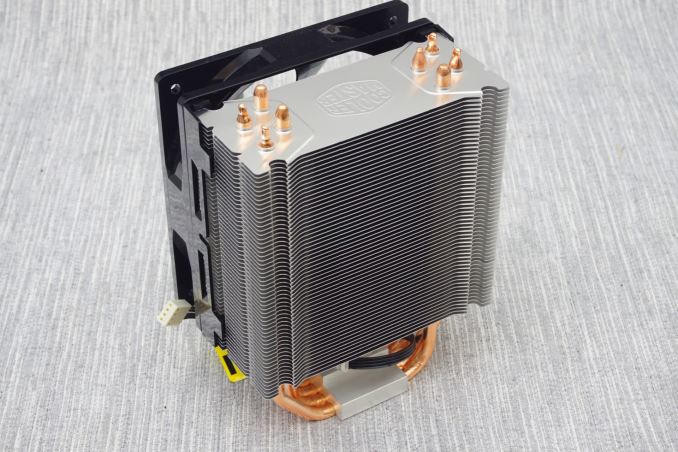Battle of The CPU Stock Coolers! 7x Intel vs 5x AMD, plus an EVO 212
by E. Fylladitakis on July 22, 2016 9:00 AM EST- Posted in
- Cases/Cooling/PSUs
- CPUs
- AMD
- Intel
- Cooler Master
- Cooler

Advanced PC users that like to care for their system commonly believe stock cooling solutions that are supplied with processors to be either barely adequate or too noisy even for a standard, unmodified system operating at stock frequencies. With bulk PC orders it is, of course, a difference scenario when every penny counts. But as a result of the perception of poor cooling from these 'default' coolers, most enthusiast users seek aftermarket cooling solutions. This has created a vast and multivariate demand, and there are so many companies offering such a wide variety of cooling products, from $20 all the way up to custom water cooling solutions. But is that really necessary for a mid-range build? We gathered together around a dozen stock coolers from across the years, from AMD and Intel, and pitted them against the highly rated EVO 212 from Cooler Master.
Introduction
Modern CPUs have become more efficient over time, and have begun to have lower cooling requirements. As a result, the CPU manufacturers have designed some rather advanced stock coolers and are either supplying them alongside their top-tier CPUs or selling them as aftermarket solutions. Despite the fact that these are the 'certified' coolers for the processors, the CPU manufacturer has to make millions, to every hundredth of a cent in manufacturing can be important to the bottom line. It is not easy for the average user to assess just how good the stock cooler really is and how much of an improvement, if any at all, there will be from the purchase of an aftermarket cooler. End users need to be aware of the performance of their current cooling solutions in order to reasonably assess the upgrade that will fit their needs.
In this review we will showcase the thermal performance of some popular stock CPU coolers of the last few years, including the controversial aftermarket Intel BXTS15A and the highly touted AMD Wraith. We also included one of the most popular mainstream coolers available, the Cooler Master EVO 212, as a baseline comparison against aftermarket solutions.
The coolers that we will be testing are in the following table, along with core/fin material listed, the size of the fan, and the overall mass of the cooler as measured on our units. Where heatpipes are in play, these are added into the Core section.
| Vendor | Cooler | Common Bundle | Core | Fins | Fan (mm) |
Mass (g) |
| Intel | D75716-002 | Socket 775 Celerons | Alu | Alu | 80 | 118 |
| C25704-002 | Socket 775 P4 6x0 | Cu | Alu | 80 | 132 | |
| E97378-001 | Socket 1155 Intel i5 | Cu | Alu | 80 | 146 | |
| E97379-001 | Socket 1155 Intel i3 | Alu | Alu | 80 | 92 | |
| D60188-001 | Socket 775, C2D E8x00 | Cu | Alu | 80 | 419 | |
| E31964-001 | Socket 1366 i7-X | Cu | Cu/Alu | 100 | 435 | |
| BXTS15A | Aftermarket, ≈$30 | Cu | Alu | 80 | 362 | |
| AMD | 1A213LQ00 | AMD “Kabini” AM1 | Alu | Alu | 50 | 75 |
| FHSA7015B | Several AMD Lines | Alu | Alu | 70 | 164 | |
| AV-Z7UB408003 | Black Edition Phenom | Alu +2 Cu HP |
Alu | 70 | 374 | |
| Wraith (125W) | AMD FX-8370 AMD A10-7890K |
Cu +4 Cu HP |
Alu | 90 | 304 | |
| Cooler Master | HK8-00005 | AMD FM2+ “Godavari” CPUs | Alu | Alu | 70 | 125 |
| EVO 212 | Aftermarket, ≈$30 | Cu +4 Cu HP |
Alu | 120 | 436 |











82 Comments
View All Comments
bigboxes - Friday, July 22, 2016 - link
Yup. My Athlon X2 4400+ (Toledo) came with a 4-pipe cooler as well. Never used the stock HSF when it was in my main rig. Got a Zalman which was badass at the time. Used the stock HSF when I moved the Athlon 3200+ (Winchester) to my file server.Marburg U - Friday, July 22, 2016 - link
OK, but just to recall that DB scale is a logarithmic scale. And the difference between 44.7 and 46.3 is roughly 45% power ratio!!!ZeDestructor - Friday, July 22, 2016 - link
Perceptually though, odds are you won't observe a difference in loudness (tone is a whole different ballgame): 3dB is the generally accepted number for human hearing to be able to perceive a difference in volume, and 10dB for a perceptual halving of volume.DanNeely - Friday, July 22, 2016 - link
But also remember that your ears are a logarithmic sensor. So while 10 dB is 10x the sound intensity, it only sounds twice as loud. In this case the 1.6 dB only corresponds to sounding about 15% louder; which is barely noticeable. Other factors like your case material (type, thickness, if sound deadening material is present, locations of fan holes, etc) affecting how much sound gets out from the CPU cooler; and the number, type, and layout if your case fans affecting how hot the internal ambient is and how hard your CPU cooler has to work will all have more significant impacts on how loud your system is.pseudoid - Friday, July 22, 2016 - link
Ummmmm....Logarithmic scale to measure Sound Pressure Levels (SPL) are normally a relative measurement based on voltage (not power). As such, an order of magnitude increase (10X) results in a 20dB (not 10dB) increase in SPL. Keeping with the same SPL measurements, a doubling (octave) or an increase of twice as loud (2x) is a 6dB increase! No need to bring up Fletcher-Munson curves into this correction. Cheers!
hailey14 - Friday, July 22, 2016 - link
"With bulk PC orders it is, of course, a "difference" scenario..."some typo.
Calculatron - Friday, July 22, 2016 - link
Wow, I knew the Wraith cooler is good, but I didn't realize that it was that good.I have the "quiet" 125 TDP cooler solution, which is the Wraith Cooler without the fancy shroud - same heatsink and fan, though. Maybe I'll keep it around...
Lolimaster - Friday, July 22, 2016 - link
The thing intel non 2011 socket cpu's uses complete trash internal dissipation compound, another reason to not sell it with stock cooler.Even with a decent one (juper 212z) you see load temps of 75°C without OC. Meanwhile their new Broadwell-E stays within the 50°C (+/- 2°C) with a similar cooler.
AMD didn't screw up users with the IHS dissipation.
ZeDestructor - Sunday, July 24, 2016 - link
As many have stated before, Intel has to use TIM on the small cores because the small cores crack from repeated thermal shock when soldered to the IHS. Intel doesn't want to screw you over, but they literally have to! Or do you want 32nm and larger lithographies back?Ascaris - Sunday, July 24, 2016 - link
They could use a bigger chunk of silicon wafer to help with heat dissipation/bond to the IHS without printing anything on it. It's not as if the smaller litho chips have gotten cheaper because of less silicon usage!